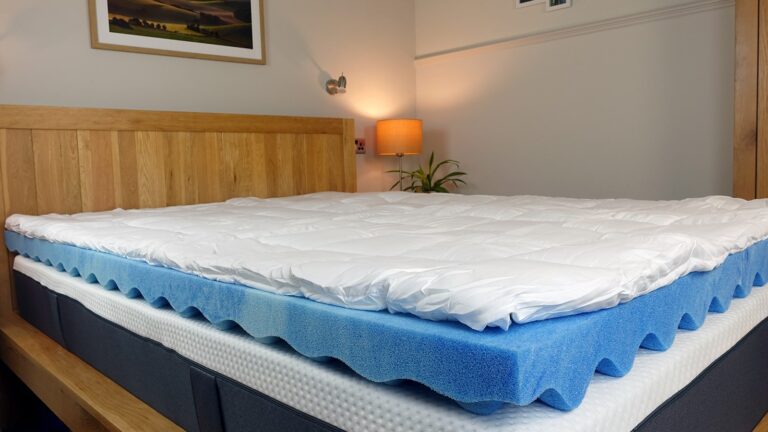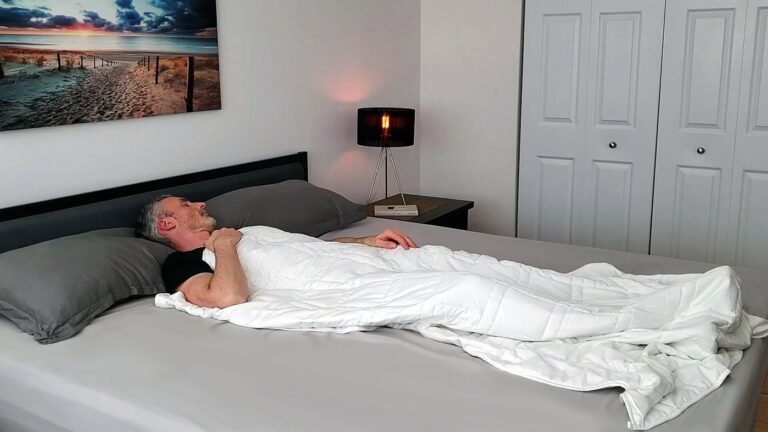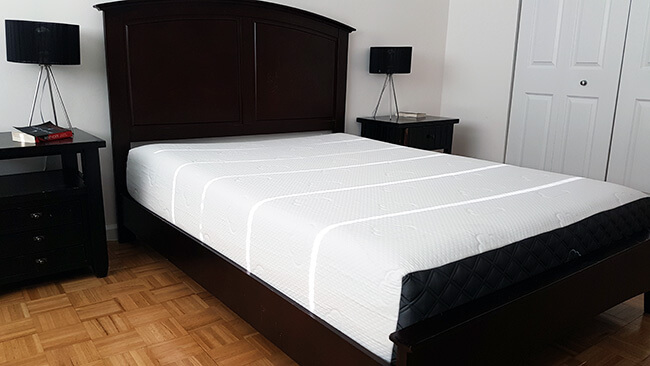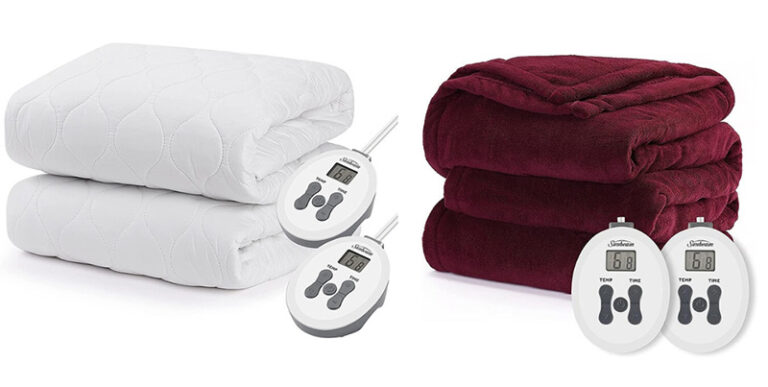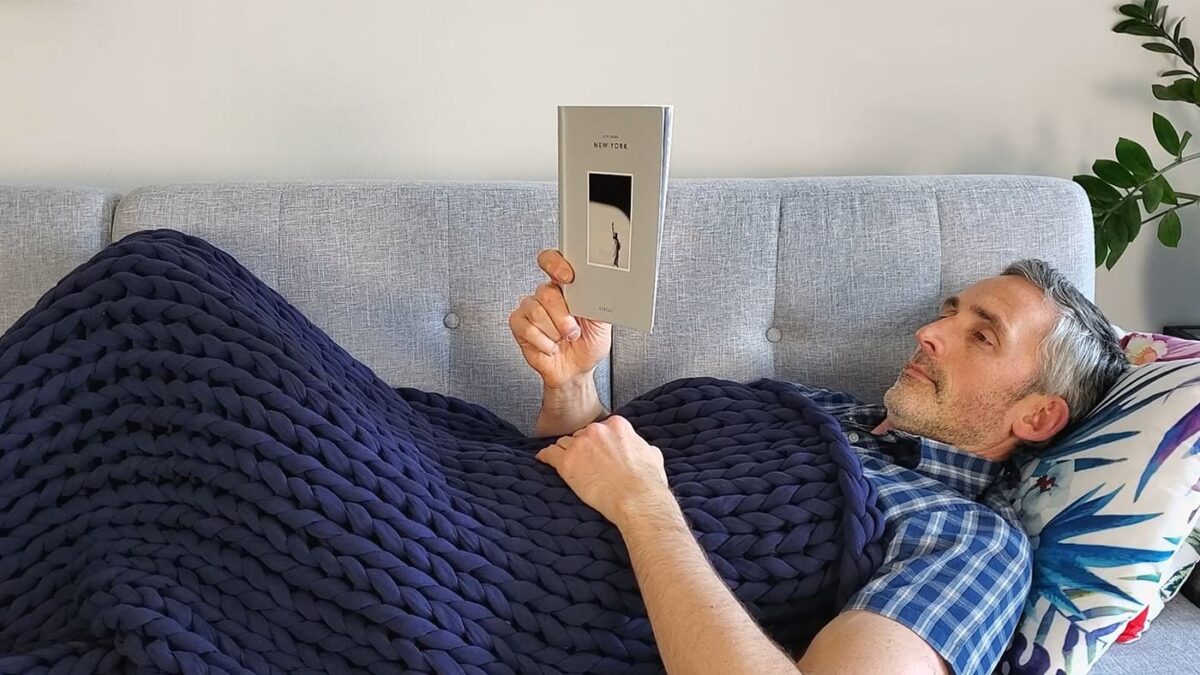
In the photo above, I’m relaxing on the sofa with a weighted blanket. This particular style uses a heavy weave to create the weight rather than glass microbeads.
Choosing a normal blanket is usually quite straightforward, with not much more to think about beyond the fabric, color, pattern, dimensions, and price.
Picking a weighted blanket can feel slightly more complicated, with extra questions about the weight, dimensions, materials, cover, and temperature.
I’ve used a range of weighted blankets in my home over the last few years, so I now have a good idea of the different options available, and how they translate into reality. If you’re thinking of getting a weighted blanket, hopefully you’ll find my thoughts and tips helpful.
Contents
Tips for choosing a weighted blanket
Which style to choose?
Choosing a weighted blanket starts with understanding the main styles available. From my experience, they can be categorized into three main groups:
1. Weighted insert + duvet cover
The most common style of weighted blanket consists of a weighted insert that has lots of pockets filled with glass beads. You can either use the insert on its own or use the included (but sometimes optional) duvet cover that attaches with loops and ties, as well as a zipper or buttons.
In the photo below, you can see how a weighted blanket insert is typically attached to the cover. It can be a bit fiddly threading the loops and tying 8-12 of those knots.
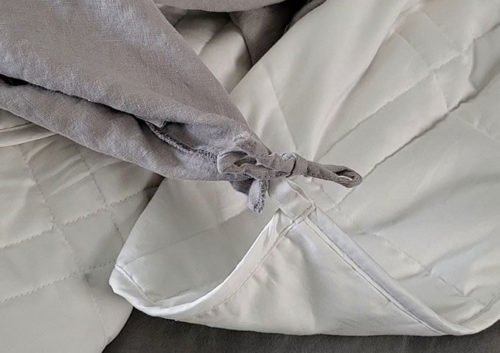
Many weighted blanket companies offer standard inserts in various weights while giving you design flexibility with the fabric, color, and pattern of the cover. This allows you to find one that matched your home decor, and it’s also much easier to wash and dry the cover than the heavy insert.
If you’re unsure about the process of removing and attaching the cover, take a look at this article and video in which I demonstrate the process from start to finish.
2. One piece / integrated cover weighted blankets
Some companies, such as Layla and Luxome, offer one piece weighted blankets with an integrated cover that you can’t remove.
The main benefit of these is that you don’t have to remove and re-attach a cover for cleaning, which can be fiddly, time-consuming, and awkward if the insert is very heavy. However, you need a strong enough washing machine and/or dryer to handle cleaning the blanket.
Below, you can see a section of the Layla weighted blanket, which doesn’t have a removable cover:
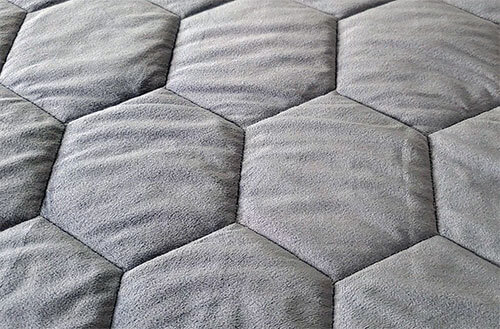
3. Chunky knit design
If you’d prefer not to have a weighted blanket that contains glass microbeads, or prefer a different feel, the third style is made with a giant chunky knit.
Essentially, the entire blanket is knitted with very large strands of cotton or polyester, making them as heavy as those containing glass beads.
Like the integrated cover style, you can avoid the faff of removing a cover for cleaning. They also have the benefit of being more breathable because the weave creates natural air holes through which more of your body heat can escape.
The main downside of the chunky knit weighted blankets in my experience is that it can take a long time to dry them. For example, my Bearaby took two cycles on a low heat setting when I first machine dried it.
In the photo below, you can see the large hand-knitted weave of the Bearaby weighted blanket:
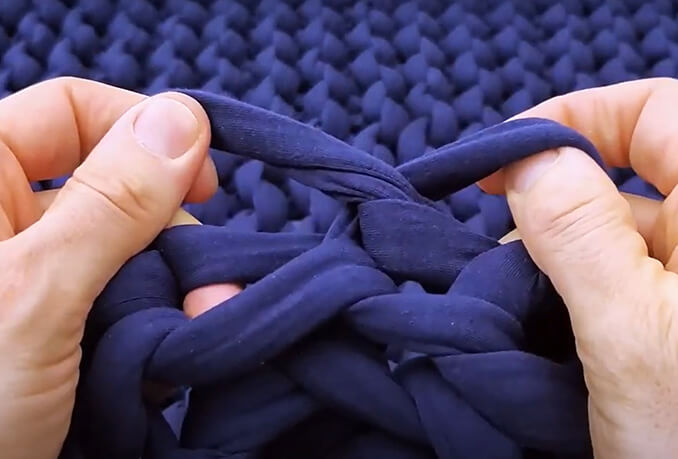
Choosing the right weighted blanket is a personal matter, with no style being the ‘right’ one. It’s just a case of deciding which particular style you like most to help narrow down your choice.
How to choose the weight
Choosing the appropriate weight for your weighted blanket can be a slightly confusing process.
One problem is that not all weighted blanket companies have the same recommendations. Another problem is that you won’t know whether a lighter or heavier weight is better for you until you try your first weighted blanket.
Some companies suggest picking one that’s 10% of your body weight. Others suggest 8% to 12% of your weight. And there are some cases where you pick based on your bed size instead as they all have the same weight per square foot anyway.
So which is it?
Method 1: Choosing based on a percentage of your own body weight
Weighted blanket manufacturers don’t typically make a 10, 11, 12, 13, 14, or 15 pound version to cater to every possible required weight. So the idea of 10% of your weight being the sweet spot won’t always work.
They are more likely to have a selection of 10, 15, 20, 25, and 30, lb blankets available. Occasionally there’s an in-between weight to choose from, such as 8 lb or 12 lb, but many seem to stick to increments of 5 lb. This is why the expanded range of choosing based on 8% to 12% of your own body weight is more practical.
If you do the maths and ideally need a 22 lb blanket, for example, you might have to decide whether to go down to 20 lb or up to 25 lb. This is a personal choice, but my experience, and those I’ve given blankets to, has been that going down in weight often feels more comfortable than going up.
In the first photo below, I’m using an individual size weighted blanket. In the second, I’m using a larger size meant for sharing. They have a similar weight, so the first one felt heavier on my body because there’s more weight per square foot.
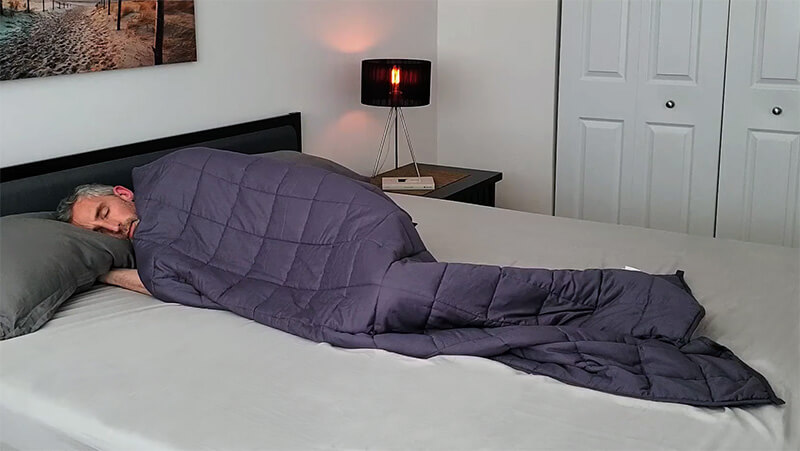
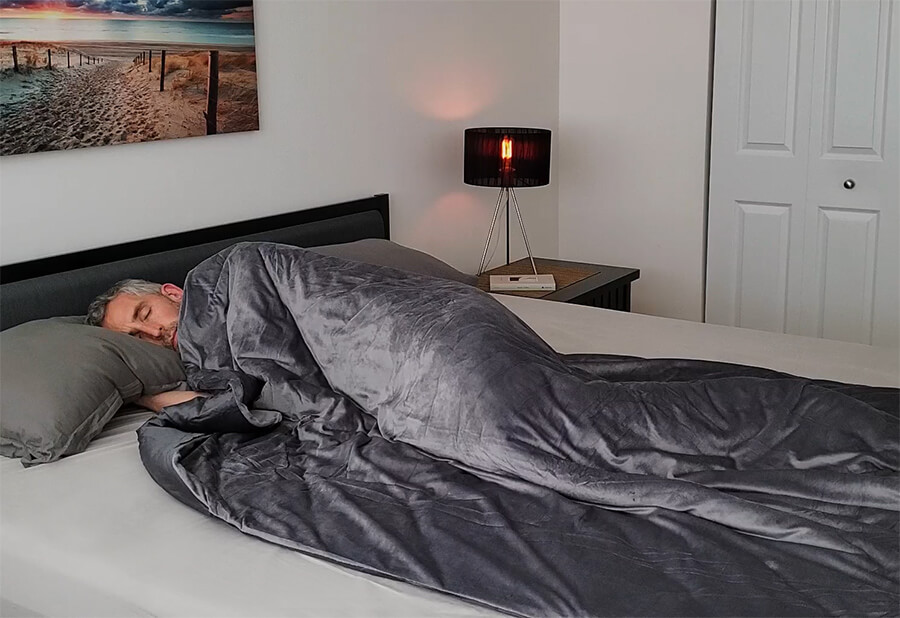
Method 2: Choosing based on your bed size
The second approach is that you have a set weight for each square foot, which a couple of manufacturers do, such as Luxome. They say they tested different weights with a wide range of people to find an average weight per square foot that most people found comfortable.
I can see some logic in that approach; two people can weigh the same but have completely different body dimensions. So an average weight per square foot across different blanket dimensions might suit more people. This also makes more sense if you want a weighted blanket that covers the entire bed rather than a single blanket on one half of a queen or king size bed.
Interestingly, three weighted blanket manufacturers I spoke to – Baloo, Gravity, and Bearaby – all told me that the most common reason for exchanges is wanting a different weight. This is a good reason to check that the company you’re buying from offers exchanges, and to be mindful of the window of time within which they permit exchanges.
One other point to consider is the width and length of the blanket. Personally, I prefer single sizes as you’ll then get most of the weight on your body rather than large sections covering parts of the bed you’re not even sleeping on. So it’s important to bear in mind that if you choose a 20 lb queen or king size, it’s not going to feel the same as a 20 lb single size.
Most weighted blanket companies offer their own guidelines for picking the size on their website. One of the most useful I’ve seen is on the Baloo website. Here’s a quote from their site with some of their key advice:
There is a commonly-heard “rule” that for a weighted blanket, you should look for about 8-12% of your body weight. However, that’s really just a guideline; there are other factors that are actually more important in choosing the right weighted blanket for you. We recommend that you select a blanket based on what size you want. Then, if you are choosing between two weights in the same size (e.g. 15lb vs. 20lb Full/Queen blankets), you can consider other factors such as how you sleep and any joint sensitivity.
The ideal blanket is meant to be relaxing, lull you to sleep, and calm your nerves; it shouldn’t be so heavy as to be uncomfortable. Make sure to consider what position you sleep in: if you’re a back or stomach sleeper you can probably handle a heavier blanket, while a side-sleeper might opt for something lighter.
Baloo.com
Taking all of the above into account then, here’s my advice:
- If you want a single size, start with one that’s roughly 8% to 12% of your weight. If you’re concerned about it feeling too heavy, it’s okay to go even lower in weight.
- If you want a large blanket to share or just to cover your larger bed, perhaps focus on companies that specifically tailor their weighted blankets to bed sizes rather than offering a very wide range of weights.
- If it’s your first weighted blanket, make sure you understand the exchange and returns policy in case the weight doesn’t suit you.
Do weighted blankets feel hot?
In my experience, most weighted blankets add warmth, especially if your bedroom is already warm or if you use them on top of your existing bedding. But there’s a big difference between the warmest and coolest ones, which is largely determined by the fabrics used and how they are filled.
For example, the Bearaby is more breathable because of all the holes between the weave, and it doesn’t trap your body heat so much.
The thicker blankets with polyester/minky covers, such as the Quility and Gravity Blanket, feel much warmer – especially after an hour or two of lying under them.
If you’re a cold sleeper, or it’s a freezing winter, you might like the snug warmth they provide. But if you’re a hot sleeper or live somewhere warm and don’t have air conditioning, one with thick polyester fiberfill padding and a minky cover might not be the best choice.
I’ve noticed in the last couple of years that some weighted blanket companies use the word ‘cooling’ quite liberally. When I checked the labels, however, it’s often the case that they just use a cooler fabric for the external cover, such as cotton or bamboo lyocell. The core weighted blanket insert is the same as the one you get if you select a warmer cover.
The fabric might feel cooler to the touch and be a bit more breathable, but it’s still a heavy blanket with lots of material that’s not going to actively cool you, which is what the word cooling suggests to me personally. If you want to be pedantic about it (which I do), perhaps the words ‘cooler’ or ‘more breathable’ would be more accurate.
My view is that it’s important to have reasonable expectations and assume a weighted blanket won’t provide any real cooling. Yes, some are more breathable than others. But if you want cooling, you need air conditioning, a fan, or some other technique – not an extra blanket.
That said, as a hot sleeper myself, I’ve had no problem using the knitted weighted blankets like the Bearaby in warmer weather. Even the Cooling Gravity Blanket, Baloo, and SlumberCloud have been tolerable in the summer unless it’s a particularly hot night.
Do you need a cover?
As I mentioned earlier, one piece and integrated weighted blankets don’t come with a cover. They may be available in different colors and patterns, though, which gives you some choice in how your blanket looks.
Many companies sell weighted blankets with a pre-attached cover, so you just choose the style and the material that appeals to you and it will arrive ready to go.
In some cases, you’re given the choice to buy a cover separately. So if you’re a hot sleeper or on a tight budget, you could just get the main weighted blanket insert and skip the cover to keep both the heat and the expense down.
However, one major benefit of having a cover is that you can just wash that, instead of having to stuff a heavy blanket into your washing machine – assuming your washing machine can cope with a 25 lb blanket (not all can).
Another point to think about with the cover is that the internal blanket doesn’t always feel so soft. It’s usually the cover that creates a luxurious feel, such as ultrasoft minky, bamboo lyocell, or cotton. And if you like the style with sensory nodes, that will normally be on the cover, not the internal blanket.
In the photo below, I’m sleeping under a weighted blanket with particularly pronounced sensory nodes. The nodes are usually just on one side, with a flatter surface on the reverse. Not all covers have the sensory nodes though, so you need to pick one specifically with them.
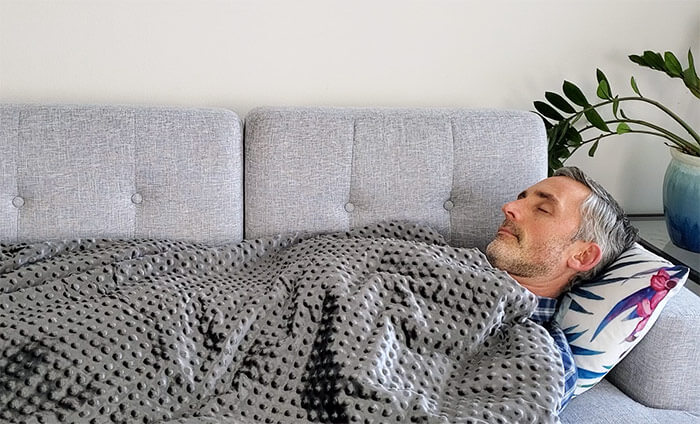
The glass microbeads used
Most weighted blankets have glass microbeads contained inside robustly stitched pockets of the internal blanket to create the weight. The cover and fabric fill will contribute a little weight, but it’s mostly the glass beads that make them feel heavy.
For those that use microbeads, there’s one important point to keep in mind: if the stitching comes undone, or a pet bites through a pocket, a lot of tiny beads are going to spill everywhere. It’s a good reason to get a blanket with strong stitching, and the main reason I think it’s good if they have more individual pockets and/or double stitching to contain each section of microbeads.
On a positive note, none of the weighted blankets I’ve personally used have ever come undone, other than the one I intentionally opened.
In the photo below, you can see how tiny the glass microbeads are. I took these out of the YNM weighted blanket.

In the next photo, I’ve opened up a pocket of the YNM weighted blanket. You can see the kind of polyester fiberfill some companies use to keep the microbeads distributed more evenly and prevent them from sliding around when you change positions.
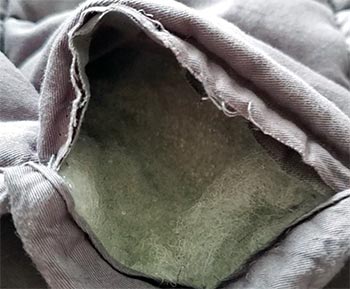
How much do weighted blankets cost?
The price of weighted blankets varies a lot from one company to the next (as with most things in life).
They do have a reputation for being quite pricey, which I think is true for some of the premium brands. As far as I can tell, these blankets often have visibly higher quality materials and more refined craftsmanship. Whether that’s worth the extra cost or not is a matter of opinion.
Here are two price examples:
The most expensive weighted blanket I bought was the Baloo with a French Flax linen cover. At the time of writing this article, it would now cost $199 for the queen size 20 lb blanket and $149 for the cover, which comes to a total of $348.
The most affordable weighted blanket I bought was the YNM in the United States. Currently, it would cost you $59.99 for a 20 lb 60″ x 80″ insert and $41.99 for a bamboo duvet cover, for a total of $101.98.
You can find weighted blankets at various price points between those two, but that should give you an idea of the upper and lower end.
Can you exchange or return weighted blankets?
If you buy one on Amazon, you’ll have the standard 30 day window to return your weighted blanket if you’re not happy with it.
Most weighted blanket companies seem to offer a 30 day window for exchanges or returns if you shop on their own website. It’s important to check their refunds policy before you buy though, as they may require you to return it in the original packaging and pay either a shipping or processing fee.
As always, read the small print to make sure you can return the blanket if you’ve opened and used it.
More information about weighted blankets
What are weighted blankets?
Weighted blankets are specialized blankets that are either filled with materials like glass beads or made with a chunky knit to add weight.
Ranging typically from 15 to 30 pounds for adults, and as light as 5 pounds for older children, they are designed to distribute even pressure across your body.
This deep pressure concept is based on a therapeutic technique called deep pressure stimulation, which is sometimes used to promote relaxation and reduce anxiety. The sensation is often described as being similar to the feeling of being hugged, swaddled, or snuggly held.
Unlike conventional blankets then, weighted blankets aren’t just about adding warmth. Their main purpose is to provide a form of sensory therapy (though they usually add some snug warmth too).
They come in various sizes, weights, and materials to cater to different personal preferences and needs, which I’ll discuss below.
How do weighted blankets work exactly, and what can they help with?
Now that we understand weighted blankets are designed around the concept of deep pressure stimulation, how exactly does this benefit you?
The theory goes that when the body experiences this kind of pressure, it responds by increasing serotonin levels in the brain. Serotonin is a neurotransmitter that plays an important role in mood regulation and is known for its ability to induce a calming effect.
Some weighted blanket manufacturers also claim that the pressure from the blanket can decrease cortisol levels, a hormone associated with stress.
The hope is that the combination of increased serotonin and decreased cortisol will help create a feeling of relaxation, reduce anxiety, and perhaps lead to better sleep quality.
There is occasionally talk of weighted blankets leading to an increase in melatonin production in the brain too, which is a key sleep hormone. However, there isn’t conclusive scientific evidence for this effect.
It’s important to note that while some people may find weighted blankets beneficial, they are not a substitute for professional medical treatment. They are a complementary tool, sometimes used alongside other therapeutic approaches for conditions like anxiety, insomnia, and sensory processing disorders.
Is there any scientific evidence that weighted blankets work?
If you’re feeling skeptical about the potential benefits of weighted blankets, there is some interesting scientific evidence that they might help some people beyond just being another way of keeping warm and cozy.
For example, a piece of research in 2008 involving 32 adults appeared to show that using a weighted blanket might help with anxiety. In the study, 33% showed a lowering of electrodermal activity, 63% reported that they felt lower anxiety after using the blanket, and 78% preferred it as a calming method.
In another study involving 120 adults in 2020, participants were given a metal chain blanket to use during sleep. It’s not the same as the commercial weighted blankets you might buy online or in shops, but the basic concept of sleeping under the pressure of added weight is similar.
The researchers found that the people who used the weighted blanket showed “significantly better sleep maintenance, a higher daytime activity level, and reduced daytime symptoms of fatigue, depression, and anxiety.”
My experience
My personal experience has been that weighted blankets give me a sense of calm at night that’s more noticeable than normal bedding. When I lie in bed under a weighted blanket, I believe the gentle pressure and feeling of being really well tucked in has a reassuring effect, especially if I’m a bit wired from a hectic day!
I also find them comforting to use on the sofa in the early evening while reading or watching a movie, though I don’t typically use them in the summer months.
As for sleep, I don’t think it’s possible to predict in advance whether a weighted blanket will help you sleep better or not. It depends on the individual, what causes your sleep problems in the first place, and how you react to the weight and pressure.
For example, if you’re a hot sleeper who sometimes feels a bit claustrophic, I can’t imagine a world in which a heavy weighted blanket that feels warm and restricts your movement will feel good. Likewise, if you’re kept awake by noisy neighbors, I don’t see how a weighted blanket would help unless the calming effect manages to override your nocturnal sensitivity to noise (which it doesn’t in my case).
If you’d like to see more studies about the effectiveness of weighted blankets, there’s a useful article on Healthline.com that summarizes some of the latest research studies into them.
Are weighted blankets safe to use?
For most healthy adults, older children and teenagers, weighted blankets are usually seen as being safe to use. However, according to WebMD.com, infants, toddlers, or very young children shouldn’t use a weighted blanket.
They also recommend consulting a doctor before using one if you have any of the following conditions:
- Sleep apnea.
- Breathing problems.
- Circulation problems.
- Any other chronic health condition.
While it’s not a safety point per se, I think it’s also important to mention that not everyone may enjoy the feeling of a weighted blanket.
For instance, if you have a tendency to feel claustrophobic, or are sensitive to touch and pressure to the extent that it can be uncomfortable, a weighted blanket may not be the right choice for you.
Similarly, if you’re someone who regularly overheats in bed, adding a large, albeit breathable, weighted blanket might not be the most suitable option.
Final thoughts
At the end of the day, the ideal weighted blanket will be one that feels comfortable to you – neither too heavy nor too light, and a pleasant texture and temperature. It may need some trial and error, but hopefully not too much as it’s always good to avoid the fuss and potential cost of exchanging or returning them.
If you’d like some information about specific brands and blankets, take a look at my recommended weighted blankets for adults.
Your questions
If you have any questions I haven’t answered in this article, feel free to ask in the comments below. I’d also love to hear about your experience of using a weighted blanket if you’ve already tried one.

